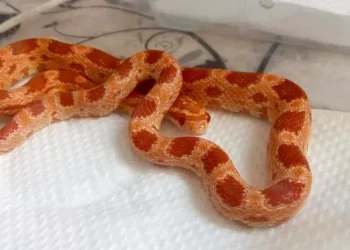Tortoiseshell cats, often affectionately called “torties,” are known for their striking, mottled coats made up of patches of black, orange, and sometimes cream or gold. The vivid, unique appearance of a tortoiseshell cat is not only eye-catching but also a testament to the fascinating genetic inheritance patterns that determine their coat color. In this article, we will explore the inheritance pattern of tortoiseshell cats, shedding light on the science behind their distinctive coats and how genetics play a role in creating such an individualistic and stunning feline.
Understanding the Tortoiseshell Coat
Before diving into the genetics, it’s important to describe what a tortoiseshell cat’s coat typically looks like. The classic tortoiseshell pattern features a combination of two colors: orange (or red) and black. These two colors appear in patches across the cat’s fur, sometimes interspersed with streaks of cream, gold, or gray. The colors can be blended, with some cats showing a marbled pattern where the colors mix together.
Tortoiseshell cats come in a variety of coat patterns, including:
Classic Tortoiseshell: Large, distinct patches of black and orange.
Dilute Tortoiseshell: A lighter version of the classic pattern, where the black is replaced by gray, and the orange is replaced by a soft cream or pastel color.
Torbie (Tortoiseshell Tabby): A tortoiseshell cat that also displays tabby markings, such as stripes, swirls, or spots.
Tortoiseshell-and-white: A tortie with patches of white fur along with the typical black and orange colors.
The Genetic Basis of Coat Color in Cats
To understand the inheritance pattern of tortoiseshell cats, we need to delve into some basic genetics. Coat color in cats is determined by a combination of genes that affect pigment production, as well as how these pigments are distributed in the fur. In general, the two main pigments involved in the color of a cat’s fur are eumelanin (black) and pheomelanin (orange or red).
The X Chromosome and Color Inheritance
The key to understanding tortoiseshell coloration lies in the X chromosome. In mammals, females have two X chromosomes (XX), while males have one X and one Y chromosome (XY). Since coat color is controlled by genes located on the X chromosome, the inheritance of this trait is directly influenced by the sex of the cat.
X-linked Inheritance: The gene responsible for the black coat color (eumelanin) is located on the X chromosome. Likewise, the gene responsible for the orange or red coat color (pheomelanin) is also carried on the X chromosome. Therefore, both the black and orange colors are linked to the X chromosome.
Male Cats: Male cats only have one X chromosome, meaning they can inherit only one color gene. If a male inherits the X chromosome carrying the black color gene, he will have a black coat, and if he inherits the X chromosome with the orange gene, he will have an orange coat. Males cannot be tortoiseshell because they only have one X chromosome and, therefore, can have only one color on that chromosome. This is why tortoiseshell cats are overwhelmingly female.
Female Cats: Female cats, on the other hand, have two X chromosomes, which means they can inherit one color gene for each X chromosome. If a female cat inherits the X chromosome with the black gene from one parent and the X chromosome with the orange gene from the other parent, she will display the classic tortoiseshell pattern—both black and orange patches in her coat. This is due to a phenomenon called X-inactivation, which we will discuss further below.
X-Inactivation and Tortoiseshell Pattern
The phenomenon of X-inactivation is central to understanding how a tortoiseshell cat’s coat pattern forms. In females, one of the two X chromosomes in each cell is randomly “turned off” during early development. This means that in different cells of a female cat’s body, one X chromosome is active while the other is inactive.
If a cat has one X chromosome carrying the black coat gene and the other X chromosome carrying the orange coat gene, in some cells, the black gene will be active, and in other cells, the orange gene will be active.
As a result, the cat’s fur will have patches of black and orange, each corresponding to the X chromosome that is active in that specific group of cells. The randomness of X-inactivation is what creates the distinct tortoiseshell pattern seen in these cats.
Interestingly, the size, shape, and arrangement of the color patches can vary widely between different tortoiseshell cats. This variation is due to the random nature of X-inactivation, and it contributes to the unique beauty of each tortie.
The Role of the White Spotting Gene
While the basic tortoiseshell coat pattern is controlled by the black and orange genes on the X chromosomes, there is often an additional factor at play: the white spotting gene. This gene can cause random patches of white fur to appear on a cat’s body, further diversifying the tortoiseshell pattern.
The white spotting gene is independent of the tortoiseshell pattern but can interact with it. This gene causes some cells to produce no pigment at all, resulting in white fur. A tortoiseshell-and-white cat, for example, has the characteristic black and orange patches but also features white fur interspersed with these colors. The distribution of white fur can vary significantly, creating different patterns that range from just a small patch of white on the chest or paws to large swaths of white covering much of the body.
The Dilute Tortoiseshell Pattern
In some cats, the black and orange pigments are diluted, creating a softer version of the tortoiseshell pattern. This is due to the dilute gene, which causes the black pigment (eumelanin) to appear as gray (blue) and the orange pigment (pheomelanin) to appear as cream.
Dilute tortoiseshell cats, often referred to as “blue-cream” cats, look similar to classic torties, but their coat colors are lighter and more pastel. The inheritance pattern for dilute tortoiseshell cats is the same as for classic tortoiseshells. The only difference is that the dilute gene causes the pigments to be lighter in color, resulting in a more subdued appearance.
Why Are Tortoiseshell Cats Almost Always Female?
As we’ve discussed, the key to tortoiseshell coat coloration lies in the X chromosomes. Since male cats have only one X chromosome, they can only carry one color gene—either black or orange—on that chromosome. Therefore, male cats cannot be tortoiseshell, as they would need two X chromosomes to inherit both the black and orange genes.
Females, on the other hand, have two X chromosomes, which means they can inherit both a black gene and an orange gene, allowing them to display the characteristic tortoiseshell coloration. This is why almost all tortoiseshell cats are female. While it is theoretically possible for a male cat to inherit two X chromosomes (a condition known as Klinefelter syndrome), this is extremely rare and results in male cats that are sterile.
The Genetics of Male Tortoiseshell Cats
Although it is very rare, male tortoiseshell cats do exist. These cats usually have an extra X chromosome, which results in a Klinefelter syndrome. In this case, the male cat has two X chromosomes and one Y chromosome (XXY). Because he has two X chromosomes, the male can inherit one X chromosome carrying the black color gene and another carrying the orange color gene, allowing him to display the tortoiseshell pattern.
Male tortoiseshell cats with this condition are often sterile because they have an abnormal number of chromosomes, which affects their reproductive system. They are also typically less healthy than females and may suffer from various medical issues due to the extra X chromosome.
Conclusion
The inheritance pattern of tortoiseshell cats is a fascinating example of how genetics determines coat color in felines. The distinctive black and orange coat pattern is the result of X-linked inheritance, where the two colors are carried on the X chromosome. Female cats, with their two X chromosomes, are able to inherit both colors, while male cats, with only one X chromosome, can only have one of the colors. This is why tortoiseshell cats are almost always female, with the rare exception of male cats with Klinefelter syndrome.
Understanding the science behind the tortoiseshell pattern not only helps us appreciate the beauty and uniqueness of these cats but also highlights the complexity of genetic inheritance in the animal kingdom. Whether you’re a cat lover or a budding geneticist, the inheritance of tortoiseshell cats is a perfect example of how genetics can shape the world around us.
Related Topics:























